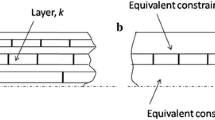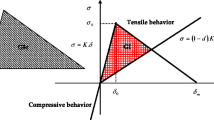Abstract
The first observed damage in a composite laminate is the matrix cracks. Although not leading to rupture, these cracks reduce the equivalent mechanical properties, leading to nonlinear stress–strain behavior. Because of the crack shielding effect (CSE), damage progression and stiffness reduction are nonlinear. Talreja has introduced an effective damage method for laminates with matrix cracks, and Singh has proposed a nonlinear model based on the method to assess stiffness reduction considering the CSE. But as Singh claimed, the model suffers from errors not addressed yet. This paper explains why Singh’s model has such limitations and presents a new anisotropic nonlinear multiscale damage model based on Talreja’s method. The model combines macro-scale continuum damage mechanics (CDM) with finite-element (FE) micromechanics. A glass/epoxy cross-ply laminate under tension is chosen as the case study, a light-transmission experiment is conducted to specify the damage progression, and an energy-based model is used to characterize it. As Talreja’s method suggests, a new function is proposed for the Helmholtz free energy, and the equations of mechanical properties in terms of the crack density are derived. FE micromechanical models with periodic boundary conditions (PBC) are developed to determine the damage constants. The model is then applied to predict the stress–strain diagram of the laminate, the results are validated by tensile and loading–unloading experiments, and compared with Singh and Talreja’s models. Also, reference state selection criteria are established for the new model to obtain the best predictions, which was impossible with Singh’s model.













Similar content being viewed by others
References
Wang H, Li B, Xuan F-Z (2022) Fatigue-life prediction of additively manufactured metals by continuous damage mechanics (CDM)-informed machine learning with sensitive features. Int J Fatigue 164:107147
Islam N, Dewees DJ, Hassan T (2022) Development of a unified constitutive model coupled with a continuum damage model for design and evaluation of high-temperature components. Int J Solids Struct 257:111935
Li Z, Ghosh S (2020) Micromechanics modeling and validation of thermal-mechanical damage in DER353 epoxy/borosilicate glass composite subject to high strain rate deformation. Int J Impact Eng 136:103414
Kil T, Bae J-H, Yang B, Lee H-K (2023) Multi-level micromechanics-based homogenization for the prediction of damage behavior of multiscale fiber-reinforced composites. Compos Struct 303:116332
Guven I, Cinar K (2019) Micromechanical modeling of particulate-filled composites using micro-CT to create representative volume elements. Int J Mech Mater Des 15:695–714
Wang Z, Yuan Y (2020) Micromechanics-based modeling of elastic modulus and coefficient of thermal expansion for CNT-metal nanocomposites: effects of waviness, clustering and aluminum carbide layer. Int J Mech Mater Des 16:783–799
Talreja R (1996) A synergistic damage mechanics approach to durability of composite material systems. Progr Durabil Anal Compos Syst 1996:117–29
Varna J (2008) Physical interpretation of parameters in synergistic continuum damage mechanics model for laminates. Compos Sci Technol 68:2592–2600
Talreja R (2006) Damage analysis for structural integrity and durability of composite materials. Fatigue Fract Eng Mater Struct 29:481–506
Varna J, Krasnikovs A, Kumar RS, Talreja R (2004) A synergistic damage mechanics approach to viscoelastic response of cracked cross-ply laminates. Int J Damage Mech 13:301–334
Singh CV, Talreja R (2010) Evolution of ply cracks in multidirectional composite laminates. Int J Solids Struct 47:1338–1349
Singh CV (2013) A higher order synergistic damage model for prediction of stiffness changes due to ply cracking in composite laminates. Comput Mater Contin 2013:227–249
Montesano J, Singh CV (2016) Progressive failure analysis of polymer composites using a synergistic damage mechanics methodology. Adv Compos Aerosp Marine Land Applcations 2016:147–55
Montesano J, Singh CV (2016) Critical stiffness damage envelopes for multidirectional laminated structures under multiaxial loading conditions. Mater Des 91:218–229
Berton T, Najafi F, Singh CV (2019) Development and implementation of a multi-scale model for matrix micro-cracking prediction in composite structures subjected to low velocity impact. Compos B Eng 168:140–151
Pao WY, Haldar S, Singh CV (2020) Performance analysis of composite helicopter blade using synergistic damage mechanics approach. AIAA J 58:968–976
Pendleton R, Tuttle M (2012) Manual on experimental methods for mechanical testing of composites. Springer Science & Business Media, Cham
Shen H, Yao W, Qi W, Zong J (2017) Experimental investigation on damage evolution in cross-ply laminates subjected to quasi-static and fatigue loading. Compos B Eng 120:10–26
Hu H, Li S, Wang J, Wang Y, Zu L (2016) FBG-based real-time evaluation of transverse cracking in cross-ply laminates. Compos Struct 138:151–160
Ghajar R, Ghadami M (2023) A novel experimental method and computational micromechanical model for in-situ damage detection and prediction of stiffness degradation in cross-ply FML. Compos Struct 305:116492
Parvizi A, Garrett K, Bailey J (1978) Constrained cracking in glass fibre-reinforced epoxy cross-ply laminates. J Mater Sci 13:195–201
Farge L, Varna J, Ayadi Z (2010) Damage characterization of a cross-ply carbon fiber/epoxy laminate by an optical measurement of the displacement field. Compos Sci Technol 70:94–101
Mortell D, Tanner D, McCarthy C (2016) An experimental investigation into multi-scale damage progression in laminated composites in bending. Compos Struct 149:33–40
Mehdikhani M, Steensels E, Standaert A, Vallons KA, Gorbatikh L, Lomov SV (2018) Multi-scale digital image correlation for detection and quantification of matrix cracks in carbon fiber composite laminates in the absence and presence of voids controlled by the cure cycle. Compos B Eng 154:138–147
Miskdjian I, Hajikazemi M, Van Paepegem W (2020) Automatic edge detection of ply cracks in glass fiber composite laminates under quasi-static and fatigue loading using multi-scale Digital Image Correlation. Compos Sci Technol 200:108401
Funding
No funds, grants, or other support was received.
Author information
Authors and Affiliations
Corresponding author
Ethics declarations
Conflict of interest
The author declares that he has no known competing financial interests or non-financial interests that could have appeared to influence the work reported in this paper.
Additional information
Publisher's Note
Springer Nature remains neutral with regard to jurisdictional claims in published maps and institutional affiliations.
Rights and permissions
Springer Nature or its licensor (e.g. a society or other partner) holds exclusive rights to this article under a publishing agreement with the author(s) or other rightsholder(s); author self-archiving of the accepted manuscript version of this article is solely governed by the terms of such publishing agreement and applicable law.
About this article
Cite this article
Ghadami, M. An anisotropic nonlinear multiscale damage model for mechanical behavior of a composite laminate with matrix cracks. Meccanica 58, 1809–1822 (2023). https://doi.org/10.1007/s11012-023-01705-x
Received:
Accepted:
Published:
Issue Date:
DOI: https://doi.org/10.1007/s11012-023-01705-x




